When you need earth moved—no matter how large or small the amount—you need some heavy machines. After all, a single cubic foot of dirt weighs about 80 pounds. So when your project calls for material handling, equipment rental offers an economical way to meet your construction machine needs.
You can find plenty of heavy-duty earthmoving vehicles in the construction industry that vary in pricing, size, and the types of tasks they perform. You can choose from backhoe loaders, bulldozers, dump trucks, excavators, motor graders, skid steer loaders, track loaders, trenchers, wheel loaders, and wheel tractor-scrapers. It all depends on your project needs, where you will be working, and how much earth needs moving.
If you need a lot of earth moved, you can rent several types of earthmoving equipment to get the job done. This guide helps you choose the right one for your next project.
1. Backhoe loader
A backhoe loader usually has a bucket on the back of it that acts as a digger capable of digging holes or uprooting trees. Depending on the size of your project, you can choose a backhoe with a large bucket or a smaller one. It also has a front loader at the front that can plow debris or other materials. You might choose this type of equipment for tasks such as small-scale demolition, including breaking up asphalt and uprooting trees.
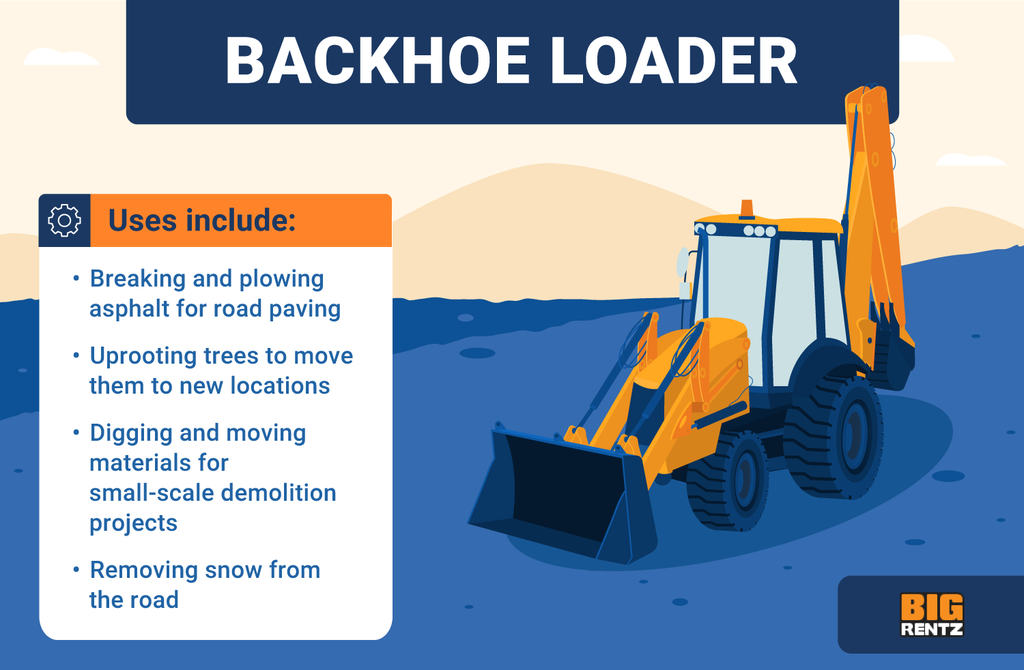
Compact backhoes can dig 6 to 8 feet down, and larger models can go up to 14 feet down. BigRentz backhoes available for rent range in horsepower from 20 to 59 horsepower for mini backhoes to 110+ horsepower for extra-large backhoes.
Explore All Backhoes
Use a backhoe if you are:
- Breaking and plowing asphalt for road paving
- Uprooting trees to move them to new locations
- Digging and moving materials for small-scale demolition projects
- Removing snow from the road
Best work sites:
- Small-scale construction projects
- Landscaping sites where digging trenches or moving or uprooting trees is necessary
Attachment options:
- Augers
- Compactors
- Hammers
- Snow handlers
- Rippers
- Couplers
- Brooms or sweepers
Rental cost for a 60-to-89-hp standard backhoe:
- Day: $252
- Week: $873
- Month: $2,133
2. Bulldozer
Bulldozers are ideal for pushing heavy materials from place to place, including specific tasks such as backfilling. You can choose from three types of bulldozers—crawler, wheel, and mini—depending on your needs. A crawler bulldozer is best for smaller sites where you want to push irregular terrain through fields or plains. Wheel bulldozers, on the other hand, are best for large earthmoving projects like leveling grounds for stadiums, and mini bulldozers are good for small spaces and residential areas.
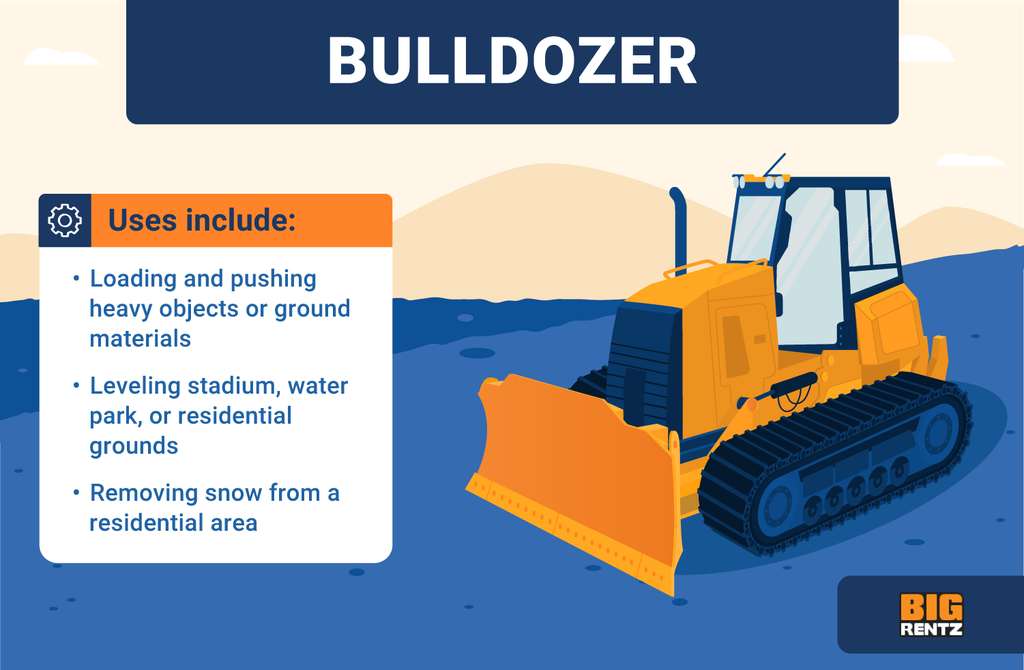
BigRentz bulldozers range in horsepower from 70- to 79-horsepower models all the way up to 200- to 249-horsepower large bulldozers.
Explore All Bulldozers
Use a bulldozer if you are:
- Loading and pushing heavy objects or ground materials
- Leveling stadium, water park, or residential grounds
- Removing snow from a residential area
Best work sites:
- Fields or plains
- Uneven and irregular terrain
- Stadium grounds
- Residential areas
Attachment options:
- S-blade
- U-blade
- Semi-U blade
- Angle blade
- Power-angle-tilt blade
Rental cost for a 70-to-79-hp bulldozer:
- Day: $433
- Week: $1,106
- Month: $3,403
3. Dump truck
Dump trucks help with transporting large amounts of materials at a time. They are often used to haul loose material, such as soil, gravel, demolition debris, and mining materials. Use a dump truck to drive materials to and from locations and then empty the contents at a destination.
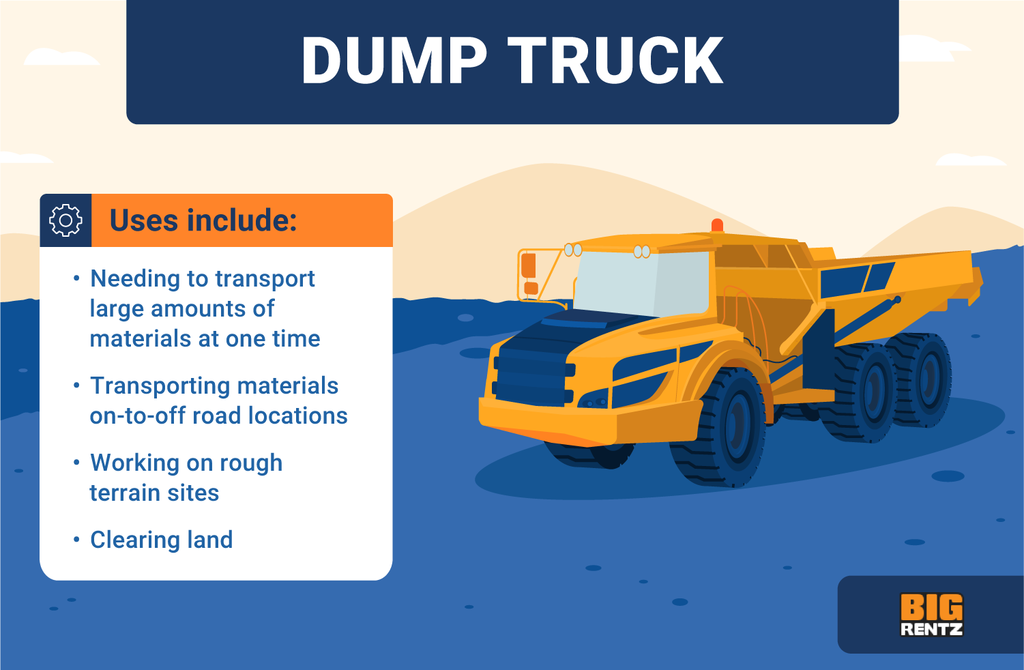
Use a dump truck if you are:
- Needing to transport large amounts of materials at one time
- Transporting materials from on-road to off-road locations
- Working on rough terrain sites
- Clearing land
Best work sites:
- Slippery muck
- Steep grades
- Deep and rugged ruts
4. Excavator
Excavators are used for digging, mining, grading landscapes, assisting with road construction, canal dredging, and the removal of debris from a construction site. Excavators come in many different sizes and have different specialties depending on the type. For example, a crawler excavator is used for digging and demolition, while mini excavators, also called compact excavators, are used for tight maneuvering in narrow job sites during a demolition. Dragline excavators offer an underwater option, used for larger-scale projects, such as dredging.
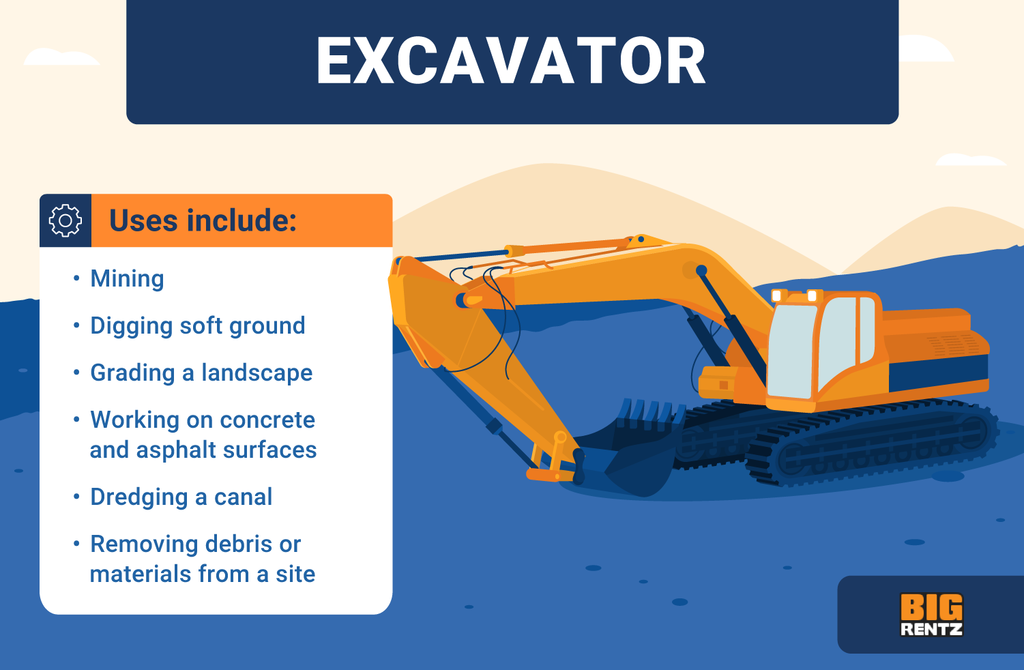
When choosing from these different sizes of excavators, consider the job you need done as well as the weight ranges for excavators before you make a choice for your job site:
- Mini excavator: With a wide weight range from about 2,000 pounds to over 22,000 pounds, mini excavators can be used best when navigating tight spaces, such as on small landscaping or demolition projects.
- Small excavator: Small-scale projects that need more power than mini excavators can benefit from the small excavator with a weight range from about 30,000 pounds to 40,000 pounds.
- Medium excavator: The next step up, when you need more reach and power, would be the medium excavator, weighing in from 48,000 pounds to 77,000 pounds.
- Large excavator: With the largest range of weight, large excavators weigh from 80,000 pounds to just over 207,000 pounds. Use these for industrial heavy construction and demolition projects on flat land.
Explore All Excavators
Use an excavator if you are:
- Mining
- Digging soft ground
- Grading a landscape
- Working on concrete and asphalt surfaces
- Dredging a canal
- Removing debris or materials from a site
Best work sites:
- Uneven terrain
- Road construction
- Dredging
Attachment options:
- Buckets
- Augers
- Breakers
- Clamps
- Couplers
Rental cost for a 20,000-to-24999-lb excavator:
- Day: $337
- Week: $1,186
- Month: $3,453
5. Motor Grader
Motor graders use a long blade to grade hard ground. They are often used for preparing a road for asphalt surfacing, which is why they are often called road graders. Motor graders come in many different models, usually based on how much power you need, the operating weight, and the blade pull.
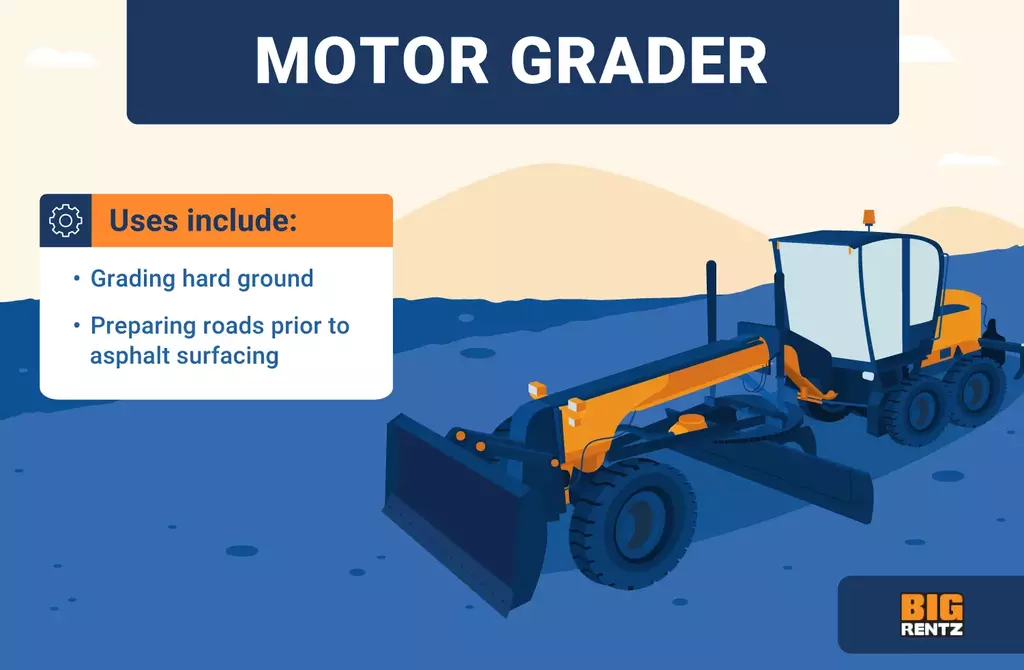
Use a motor grader if you are:
- Grading hard ground
- Preparing roads prior to asphalt surfacing
Best work sites:
- Hard ground
- Steep hills
Attachment options:
- Ripper
- Tow hitch
- Push block
- Scarifier
- Front blade
6. Skid Steer Loader
A skid steer loader is best suited for digging on the job site. They are typically used for demolition or excavation work and must be transported to the site by semi-truck. A skid steer loader has four wheels and two tracks, and because the wheels can’t turn together, the operator must increase the speed of the wheels on the right or left side engines to turn the equipment.
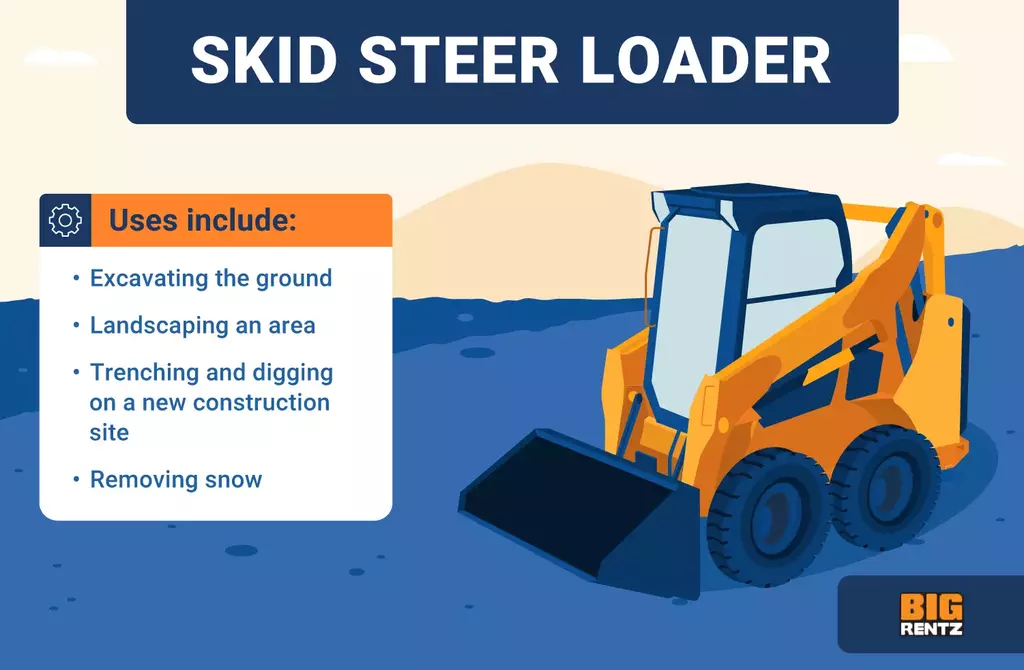
It’s a very versatile type of loader since it has many attachments, and therefore can perform many jobs. For example, you could use a bucket to lift materials or use a ripper attachment to excavate the ground. Although it looks similar to a track loader and works in the same way, a skid steer is designed to work better on hard surfaces like asphalt and concrete as well as rocky terrain.
They carry lighter loads, and their lightweight design makes them easier to transport than track loaders. When needing to maneuver better in tight spaces, the small-frame skid steer makes a great fit.
BigRentz skid steer loaders range from 500 to 3,999 pounds.
Explore All Skid Steers
Use a skid steer loader if you are:
- Excavating the ground
- Landscaping an area
- Trenching and digging on a new construction site
- Removing snow
Best work sites:
- Hard surfaces such as asphalt, concrete, or pavement
- Small spaces
Attachment options:
- Augers
- Buckets
- Dozer blades
- Backhoes
- Bale spears
- Saws
- Brush chippers
- Snow plows
- Trenchers
- Brooms
- Pallet forks
Rental cost for a 700-to-999-lb wheel skid steer loader:
- Day: $147
- Week: $404
- Month: $1,296
7. Track Loader
A track loader is a type of skid steer loader, but it uses tracks instead of wheels, making it ideal for muddy and uneven terrain. Track loaders perform many of the same tasks as skid steers—usually excavating, landscaping, and digging—but the traction offered by its tracks as opposed to tires makes it capable of handling heavier loads.
Plus, the tracks allow it to operate better on soft soils. It should not be used on hard surfaces like asphalt because it can damage the tracks, causing them to wear out prematurely.
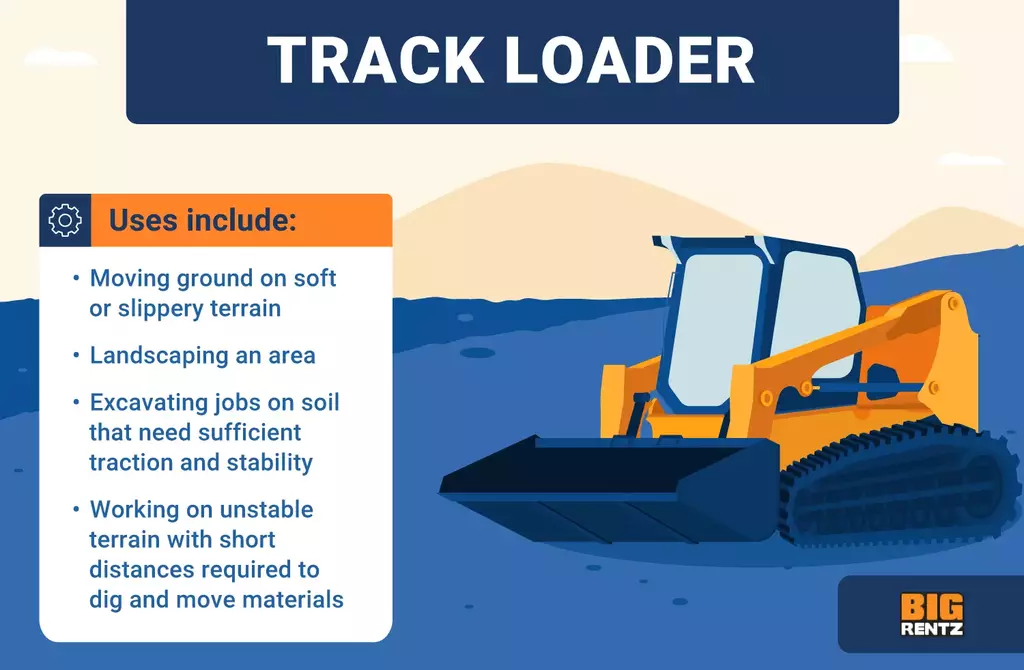
Explore All Skid Steers
Use a track loader if you are:
- Moving ground on soft or slippery terrain
- Landscaping an area
- Excavating jobs on soil that need sufficient traction and stability
- Working on unstable terrain with short distances required to dig and move materials
Best work sites:
- Undeveloped and uneven terrain
- Soft and slippery muddy ground
- Short distances between tasks
Attachment options:
- Augers
- Buckets
- Dozer blades
- Backhoes
- Bale spears
- Saws
- Brush chippers
- Snow plows
- Trenchers
- Brooms
- Pallet forks
Rental cost for a 500-to-999-lb track skid steer loader:
- Day: $220
- Week: $654
- Month: $1,868
8. Tractor
Tractors are versatile pieces of equipment commonly used for clearing land, farming, and landscaping tasks, such as leveling ground, digging ponds, mowing lawns, and digging drainage channels. Tractors come in several varieties for a range of applications, from crawlers to wheeled and industrial to landscaping.
Each has its own specialties—for example, a crawler is best for pushing heavy materials with a front-loader on rough terrain, while an industrial tractor is best used as construction equipment for moving materials around on industrial projects. Tractors can range from as low as 22.4-horsepower to heavy-duty 640-horsepower models.
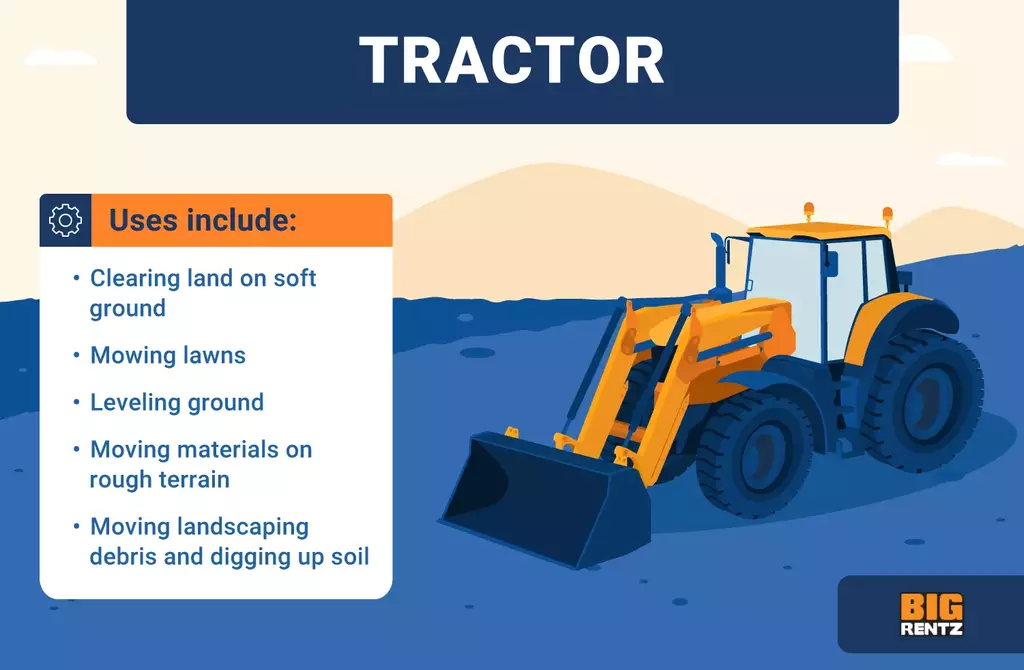
Explore All Skip Loaders
Use a tractor if you are:
- Clearing land on soft ground
- Mowing lawns
- Leveling ground
- Moving materials on rough terrain
- Moving landscaping debris and digging up soil
Best work sites:
- Rough ground
- Farms and agricultural settings
Attachment options:
- Buckets
- Forks
- Mowers
- Spreaders
- Sprayers
- Box scrapers
- Wood chippers
- Front-end loader blades
- Augers
- Backhoes
9. Trencher
A trencher has the specific purpose of trench-digging, which it does by lifting and moving earth. They don’t dig ditches in the ground like an excavator, instead they use their unique mechanical motion to create trenches. Trenchers can be used in several ways, like digging for electrical wires, cutting pavement, and creating drainage. They can even be used to snap tree roots.
There are chain trenchers, which cut into the ground to allow for narrow and deep trenches; wheel trenchers, best for soft or hard soils when there are rock formations; and micro trenchers, good for very narrow trenches of just an inch or so in width. They can be walk-behind or ride-on, with the former being better for small jobs.

BigRentz trenchers range from an 18-inch ride-on to a 66-inch ride-on.
Explore All Trenchers
Use a trencher if you are:
- Cutting trenches through pavement
- Digging for electrical wires or piping
- Creating drainage trenches
- Snipping roots
Best work sites:
- Pavement
- Hard terrain
Attachment options:
- Cutting blade
Rental cost for a 36-in ride-on trencher:
- Day: $133
- Week: $380
- Month: $1,074
10. Wheel Loader
Wheel loaders use a front-mounted bucket to dig into the ground and scoop up materials like soil, rock, and debris. The types of loaders include skid, track, and backhoe loaders, with all of them having multiple purposes.
The wheels allow the operator to move materials from place to place and from vehicle to vehicle with ease. BigRentz wheel loaders range from 2-cubic-yard articulating wheel loaders to a 4-cubic-yard version.
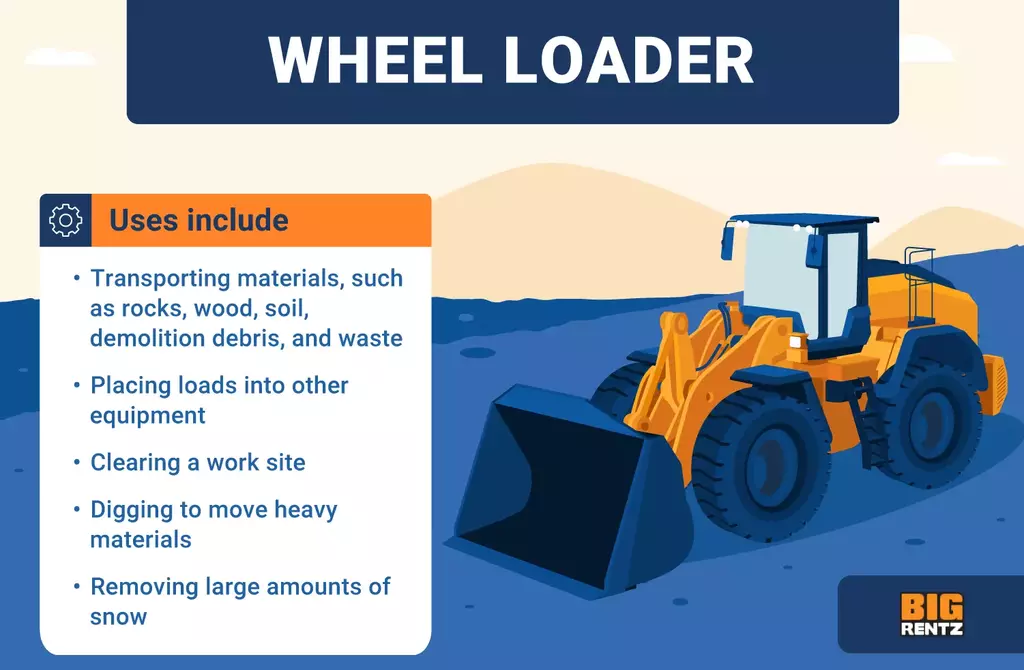
Explore All Wheel Loaders
Use a wheel loader if you are:
- Transporting materials, such as rocks, wood, soil, demolition debris, and waste
- Placing loads into other equipment
- Clearing a work site
- Digging to move heavy materials
- Removing large amounts of snow
Best work sites:
- Uneven terrain with rocks, wood, soil, demolition debris, or waste
Attachment options:
- Buckets
- Forks
- Couplers
- Rakes
- Pushers
- Shovels
- Augers
- Brooms
- Stump grinders
Rental cost for a 2-cubic-yard articulating wheel loader:
- Day: $433
- Week: $1,267
- Month: $3,425
11. Wheel Tractor-Scraper
The wheel tractor-scraper is a large machine that uses its rear hopper to flatten surfaces and clear areas. When the front end’s sharp edge cuts and flattens materials like wood or soil, it transfers that material from one location to a new one, which simultaneously clears the area. There are coal bowl scrapers, elevating scrapers, and open bowl scrapers, depending on your needs.
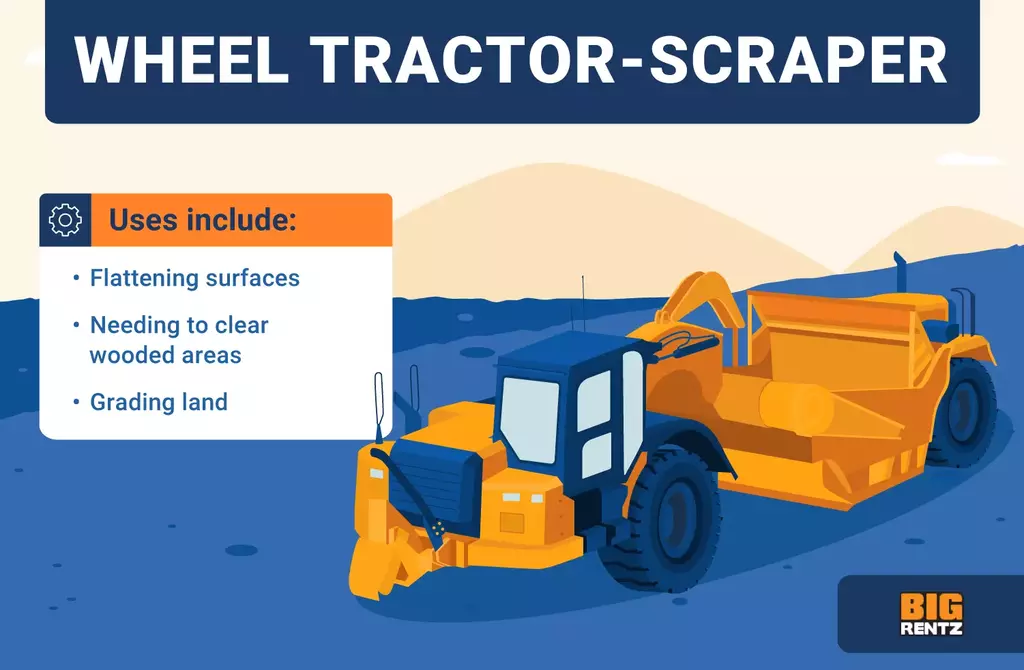
Use a wheel tractor-scraper if you are:
- Flattening surfaces
- Needing to clear wooded areas
- Grading land
Best work sites:
- Coal mining
- Construction
- Wooded areas
Operate earthmoving equipment safely
When it comes to earthmoving, remember you’re dealing with heavy equipment, which can be dangerous if you don’t know what you’re doing. If you don’t follow proper safety procedures, it could result in injury or death. Always have an operator who is trained and certified on that machine before allowing them to do work on it. Here are a few other things you can do as well:
- Wear personal protective equipment. Make sure operators and the workers in the vicinity have the proper gear to protect themselves from potential injuries.
- Check the equipment prior to use. Always inspect the equipment before use to spot any potential hazards.
- Clearly communicate. Keep everyone informed about when and where the equipment will be operating so they can keep a safe distance.
- Schedule maintenance as necessary. Perform regular maintenance to ensure the machine works properly and doesn’t have a dangerous malfunction.
- Rent updated equipment. Rather than use old equipment that has a high likelihood of malfunctioning in an unsafe way, use updated rental equipment.
If you’re looking to move a lot of earth, we’ve got you covered with BigRentz’s earthmoving equipment, which will help you do your job more efficiently and safely. Contact us today so we can find the right piece of equipment for your next project.
Explore All Earthmoving Equipment